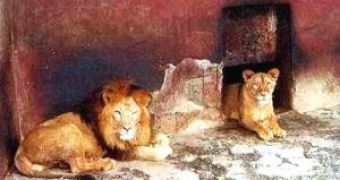The future of the lions in some African areas seems to be bleak, as researchers have unveiled an increasing man-eating behavior among individuals in those populations.
The human- man-eating behavior may have reached all time highs in Africa. Environmentalists might have to change methods in order to protect both villagers and animals. "Each year, more than 200 Tanzanians are killed by lions, elephants, crocodiles and hippos," said Robert R. Frump, a well known conservationist.
"Until conservationists and environmentalists understand the consequences of this terrible toll, wildlife will be seen more as a negative than a positive by African villagers and so will be endangered in the long run."
For a long time, Frump has studied the problem of the man-eaters in the South-African Kruger National Park. "Kruger is horrible, but Tanzania makes Kruger look like a shopping mall," Frump said. "In Kruger, refugees passing through the park are attacked and eaten and that is awful. In Tanzania, in some of the southern villages, the lions literally go door to door and seize peaceful farmers and their children from mud huts and front porches."
"That is a horror beyond imagination until you meet the villagers," Mr. Frump said.
"Often, all they have to face 400 pound lions is a machete and fish nets."
A recent study made in Tanzania showed that the rate of lion attacks has tripled since 1990. If the human loss is not addressed, the ones to suffer will be the lions.
On the other hand, rare Abyssinian lion (photo) cubs are being poisoned at the Ethiopian capital Addis Ababa Zoo, and their bodies are then sold on to be stuffed. Six cubs have been poisoned this year so far and the total number of cubs killed till now remains unclear. The official put behind these facts the lack of money and space to look after these animals, Ethiopia's national symbol which adorns statues and local currency. Currently, the Zoo harbors 16 adult lions and three cubs in cages surrounded by barbed wire. "We can send them to the forest and to some governmental palaces but most of the time we send them to the taxidermists," said the Lion Zoo administrator Muhedin Abdulaziz.
Local and international conservationists are angry with this situation. The Abyssinian lion (Panthera leo roosevelti) is a distinct subspecies characterized by its smaller size and the black mane of the males. Wildlife experts estimate no more than 1000 wild individuals left in Ethiopia's game parks, which are under the pressure of poaching, as they are killed for they skin, valued at US$1,000 on the black market.
One Ethiopian conservationist said he had been offered 11 cubs last year. He would like to see sanctuaries set up around the country for the lion cubs. "If we have a sanctuary, or maybe we can reintroduce them back into the wild, that can preserve natural resources," he said.
"For the time-being our immediate solution is to send them to the taxidermists but the final and best solution is to extend the zoo into a wider area." said Abdulaziz.

 14 DAY TRIAL //
14 DAY TRIAL //